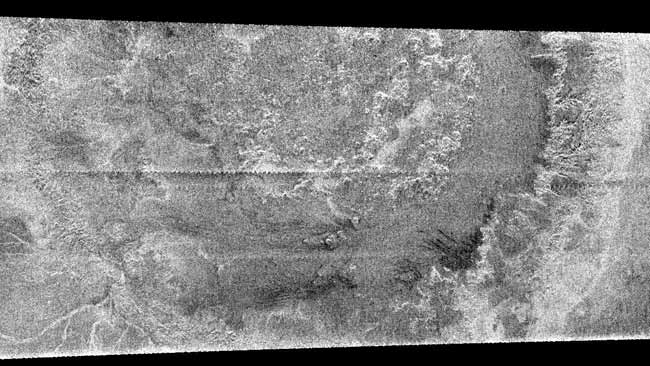Astronomers Puzzled by Titan's Missing Craters

The Cassini spacecraft's radar sweep of Saturn's largest moon Titan in January revealed a portion of what appears to be a 110 mile (180 kilometer) diameter impact crater.
If its impact origin is confirmed it would only be the fourth such crater discovered on Titan, a surprisingly small number.
Impact cratering is pervasive in our solar system, and the number of craters on the surface of a moon or planet can reveal its age in just the same way the accumulation of potholes on a highway reveals how long ago the asphalt was laid.
Earth's Moon remains heavily pockmarked because it has no significant weather or geological processes to wipe its face clean. Earth, similarly bombarded over the eons, shows many scars from relatively recent impacts that have not had time to weather away. Craters are common on several other satellites of Saturn.
"If Titan's surface had the same density of craters that other Saturnian moons have, there should be thousands of craters," said Ralph Lorenz of the Johns Hopkins University Applied Physics Laboratory. "With radar having examined about 10 percent of Titan's surface, we have only three definite craters, and perhaps a half-dozen probables."
Far too few
The trio of impact craters confirmed to date are named Menrva, Sinlap and Ksa and have diameters of 273 miles (440 kilometers), 50 miles (80 kilometers) and 17 miles (28 kilometers), respectively.
Get the Space.com Newsletter
Breaking space news, the latest updates on rocket launches, skywatching events and more!
Titan's thick nitrogen atmosphere hinders the formation of impact craters less than about 12 miles (20 kilometers) in diameter, because smaller space rocks burn up before they reach the surface. This is one reason the shrouded moon's crater count is so modest.
As Cassini continues to map up to 30 percent of Titan's surface at radar wavelengths the crater tally is set to grow.
"We've seen three craters on 10 percent of the surface, so we will probably find another 10 to 30. Maybe there are 30-100 in total, although we will need a follow-on mission to Titan to find and document them all," Lorenz told SPACE.com.
Still, researchers consider the surface nearly pothole free when it should be on the road to ruin. Something yet to be determined must be keeping the crater count down.
Buried
Clues to Titan's smooth finish can be seen in the presence of vast tracts of sand dunes, river channels and evidence for cryovolcanism visible in Cassini images.
It is likely that a combination of burial in sand, erosion by methane or obliteration by the cold hand of cryovolcanism is responsible for paving over the craters. Cassini has already spotted vague circular features among Titan's sand dunes that may be evidence of craters undergoing burial.
Pinning down the rate of crater removal will be an important factor in dating the age of Titan's surface features, including those craters that have survived.
The road toward life
Though craters are the most obvious legacy of impacts, these dramatic events can leave much more than a hole in the ground. Indeed, the shock of an impact can affect the atmosphere. In Titan's case, a big blow can add ethylene to the mix and aid the conversion of ammonia into molecular nitrogen.
Chemical reactions on Titan's surface might also be instigated by impacts and though the craters may be few and far between, fresher examples such as Ksa could be biologically interesting sites for future missions to veer toward.
It's possible that for a brief period, the heat of an impact could create liquid water on a moon that is otherwise icy cold.
Such organics when exposed to water in the laboratory have been seen to form the prebiotic molecules essential to the formation of proteins and DNA.
"So in the thousands of years it might take for this water to freeze, some very interesting prebiotic synthesis can occur. No-one knows how close to self-replicating chemical systems such environments might get before they freeze solid. Perhaps by visiting Titan in the future with a lander or balloon able to sample such material we can find out," Lorenz said.
- Saturn's Moon Titan a World of Rivers and Lakes
- Saharan Sand Dunes Found on Saturn's Moon Titan
- The Strangest Things in Space
Join our Space Forums to keep talking space on the latest missions, night sky and more! And if you have a news tip, correction or comment, let us know at: community@space.com.
David Powell is a space reporter and Space.com contributor from 2006 to 2008, covering a wide range of astronomy and space exploration topics. Powell's Space.com coveage range from the death dive of NASA's Cassini spacecraft into Saturn to space debris and lunar exploration.









